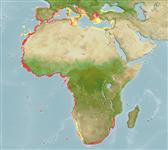Common names from other countries
Elasmobranchii (haaien en roggen) (sharks and rays) >
Myliobatiformes (Stingrays) >
Myliobatidae (Eagle and manta rays)
Etymology: Aetomylaeus: Greek, aetos = eagle + Greek, mylio = mill, grinder (Ref. 45335).
Environment: milieu / climate zone / depth range / distribution range
Ecologie
marien; brak water benthopelagisch; diepte 10 - 150 m (Ref. 6808). Subtropical; 44°N - 35°S, 19°W - 36°E
Eastern Atlantic: Portugal and Morocco to Angola, including the Mediterranean, Madeira and the Canary Islands; then from Saldanha Bay to Natal (South Africa) and southern Mozambique (Ref. 5578).
Lengte bij maturiteit / Grootte / Gewicht / Leeftijd
Maturity: Lm 90.0, range 35 - 148 cm
Max length : 222.0 cm WD (female); common length : 150 cm WD mannelijk / geslacht onbekend; (Ref. 57025); max. gepubliceerd gewicht: 116.0 kg (Ref. 85836)
Korte beschrijving
Determinatiesleutels | Morfologie | Morfometrie
Long, flat, rounded snout like a duck's bill; head thick and pectoral disc with sharply curved, angular corners; upper or lower jaw; usually with 7 rows of flat teeth (Ref. 5578). Light brown with several pale blue-grey stripes (may be absent) dorsally, white ventrally (Ref. 5578).
Found in coastal tropical and warm temperate waters, occasionally offshore. Sometimes found in small groups (Ref. 5578). Feed on bottom-living crustaceans and mollusks. Ovoviviparous (Ref. 50449), aplacental (Ref. 57025). Prized angling fish, often released (Ref. 5578). Flesh highly esteemed (Ref. 3965).
Exhibit ovoviparity (aplacental viviparity), with embryos feeding initially on yolk, then receiving additional nourishment from the mother by indirect absorption of uterine fluid enriched with mucus, fat or protein through specialised structures (Ref. 50449). Gestation about 6 months; 3-7 young produced (Ref. 5578). Size at birth 45 cm WD (Ref. 6677).
White, W.T., 2014. A revised generic arrangement for the eagle ray family Myliobatidae, with definitions for the valid genera. Zootaxa 3860(2):149-166. (Ref. 97392)
Status op de Rode Lijst van het IUCN (Ref. 130435)
CITES (Ref. 128078)
Not Evaluated
Gevaar voor de mens
Harmless
Gebruik door de mens
Visserij: commercieel; sportvis: ja
Tools
Speciale rapporten
Download XML
Internetbronnen
Estimates based on models
Preferred temperature (Ref.
115969): 13.7 - 24.5, mean 17.2 (based on 196 cells).
Fylogenetische diversiteitsindex (Ref.
82804): PD
50 = 0.5078 [Uniqueness, from 0.5 = low to 2.0 = high].
Bayesian length-weight: a=0.00389 (0.00123 - 0.01235), b=3.08 (2.82 - 3.34), in cm Total Length, based on LWR estimates for this (Sub)family-body shape (Ref.
93245).
Trofisch niveau (Ref.
69278): 3.8 ±0.57 se; based on food items.
Weerstandsvermogen (Ref.
120179): Zeer laag, minimale populatieverdubbelingstijd meer dan 14 jaar (Fec=3).
Fishing Vulnerability (Ref.
59153): Very high vulnerability (83 of 100).
